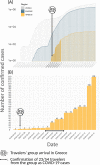Tracing the First Days of the SARS-CoV-2 Pandemic in Greece and the Role of the First Imported Group of Travelers
- PMID: 36409093
- PMCID: PMC9769540
- DOI: 10.1128/spectrum.02134-22
Tracing the First Days of the SARS-CoV-2 Pandemic in Greece and the Role of the First Imported Group of Travelers
Abstract
The first SARS-CoV-2 case in Greece was confirmed on February 26, 2020, and since then, multiple strains have circulated the country, leading to regional and country-wide outbreaks. Our aim is to enlighten the events that took place during the first days of the SARS-CoV-2 pandemic in Greece, focusing on the role of the first imported group of travelers. We used whole-genome SARS-CoV-2 sequences obtained from the infected travelers of the group as well as Greece-derived and globally subsampled sequences and applied dedicated phylogenetics and phylodynamics tools as well as in-house-developed bioinformatics pipelines. Our analyses reveal the genetic variants circulating in Greece during the first days of the pandemic and the role of the group's imported strains in the course of the first pandemic wave in Greece. The strain that dominated in Greece throughout the first wave, bearing the D614G mutation, was primarily imported from a certain group of travelers, while molecular and clinical data suggest that the infection of the travelers occurred in Egypt. Founder effects early in the pandemic are important for the success of certain strains, as those arriving early, several times, and to diverse locations lead to the formation of large transmission clusters that can be estimated using molecular epidemiology approaches and can be a useful surveillance tool for the prioritization of nonpharmaceutical interventions and combating present and future outbreaks. IMPORTANCE The strain that dominated in Greece during the first pandemic wave was primarily imported from a group of returning travelers in February 2020, while molecular and clinical data suggest that the origin of the transmission was Egypt. The observed molecular transmission clusters reflect the transmission dynamics of this particular strain bearing the D614G mutation while highlighting the necessity of their use as a surveillance tool for the prioritization of nonpharmaceutical interventions and combating present and future outbreaks.
Keywords: SARS-CoV-2; infectious disease surveillance; molecular epidemiology; phylodynamics; phylogenetics; transmission clusters.
Conflict of interest statement
The authors declare no conflict of interest.
Figures




Similar articles
-
New Surveillance Metrics for Alerting Community-Acquired Outbreaks of Emerging SARS-CoV-2 Variants Using Imported Case Data: Bayesian Markov Chain Monte Carlo Approach.JMIR Public Health Surveill. 2022 Nov 25;8(11):e40866. doi: 10.2196/40866. JMIR Public Health Surveill. 2022. PMID: 36265134 Free PMC article.
-
Systematic Genomic Surveillance of SARS-CoV-2 at Xiamen International Airport and the Port of Xiamen Reveals the Importance of Incoming Travelers in Lineage Diversity.Viruses. 2024 Jan 17;16(1):132. doi: 10.3390/v16010132. Viruses. 2024. PMID: 38257832 Free PMC article.
-
Genomic analysis of early transmissibility assessment of the D614G mutant strain of SARS-CoV-2 in travelers returning to Taiwan from the United States of America.PeerJ. 2021 Sep 2;9:e11991. doi: 10.7717/peerj.11991. eCollection 2021. PeerJ. 2021. PMID: 34557346 Free PMC article.
-
SARS-CoV-2 cold-chain transmission: Characteristics, risks, and strategies.J Med Virol. 2022 Aug;94(8):3540-3547. doi: 10.1002/jmv.27750. Epub 2022 Apr 8. J Med Virol. 2022. PMID: 35355277 Free PMC article. Review.
-
Lethal zoonotic coronavirus infections of humans - comparative phylogenetics, epidemiology, transmission, and clinical features of coronavirus disease 2019, The Middle East respiratory syndrome and severe acute respiratory syndrome.Curr Opin Pulm Med. 2021 May 1;27(3):146-154. doi: 10.1097/MCP.0000000000000774. Curr Opin Pulm Med. 2021. PMID: 33660619 Review.
Cited by
-
Indirect Costs Arising From COVID-19-Related Work Absenteeism From October 2020 to July 2022: A Retrospective Study From Central Greece.Cureus. 2025 Mar 28;17(3):e81358. doi: 10.7759/cureus.81358. eCollection 2025 Mar. Cureus. 2025. PMID: 40291212 Free PMC article.
References
-
- European Centre for Disease Prevention and Control. COVID-19 datasets. Available at www.ecdc.europa.eu/en/covid-19/data.
-
- Korber B, Fischer WM, Gnanakaran S, Yoon H, Theiler J, Abfalterer W, Hengartner N, Giorgi EE, Bhattacharya T, Foley B, Hastie KM, Parker MD, Partridge DG, Evans CM, Freeman TM, de Silva TI, McDanal C, Perez LG, Tang H, Moon-Walker A, Whelan SP, LaBranche CC, Saphire EO, Montefiori DC. Sheffield COVID-19 Genomics Group. 2020. Tracking changes in SARS-CoV-2 spike: evidence that D614G increases infectivity of the COVID-19 virus. Cell 182:812–827.e19. doi:10.1016/j.cell.2020.06.043. - DOI - PMC - PubMed
-
- Hoffmann M, Kleine-Weber H, Schroeder S, Krüger N, Herrler T, Erichsen S, Schiergens TS, Herrler G, Wu N-H, Nitsche A, Müller MA, Drosten C, Pöhlmann S. 2020. SARS-CoV-2 cell entry depends on ACE2 and TMPRSS2 and is blocked by a clinically proven protease inhibitor. Cell 181:271–280.e8. doi:10.1016/j.cell.2020.02.052. - DOI - PMC - PubMed
Publication types
MeSH terms
LinkOut - more resources
Full Text Sources
Medical
Miscellaneous

